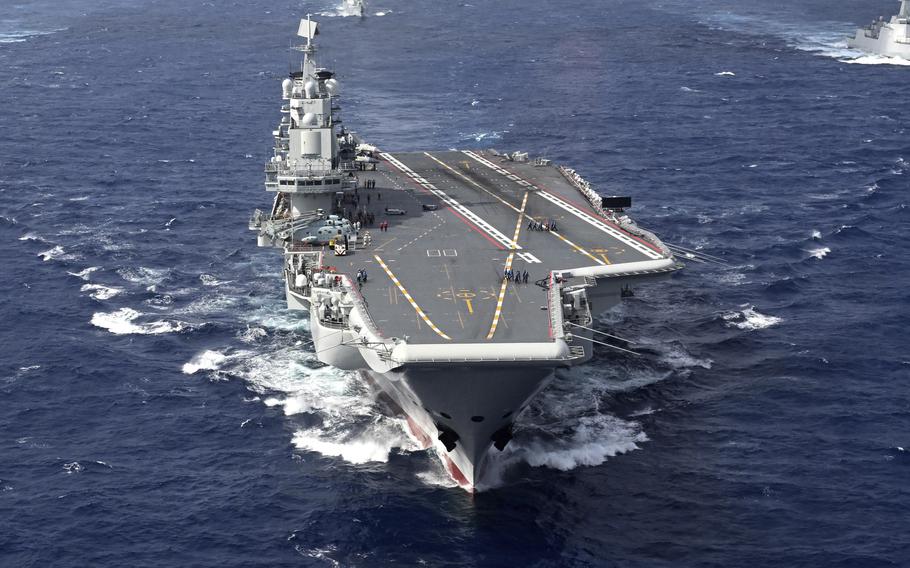
The Chinese aircraft carrier Liaoning sails in the South China Sea in October 2024. (Pu Haiyang/Xinhua News Agency via AP)
TOKYO — Japan this week confirmed that two Chinese aircraft carriers have operated together for the first time in the Pacific, fueling Tokyo’s concern about Beijing’s rapidly expanding military activity far beyond its borders.
Aircraft carriers are critical to projecting power at a distance. China routinely sends coast guard vessels, warships and warplanes to areas around the disputed East China Sea islands, but now it is going as far as what’s called the second-island chain that includes Guam — a U.S. territory. A single Chinese carrier has ventured into the Pacific in the past, but never east of that chain until now.
The presence of Chinese carriers coincides with the resumed patrol of the USS George Washington, an American aircraft carrier, from Japan.
Here’s what to know about the latest moves by China, which has the world’s largest navy numerically.
Japan’s Defense Ministry said the two carriers, the Liaoning and the Shandong, were seen separately but almost simultaneously operating near southern islands in the Pacific for the first time. Both operated in waters off Iwo Jima, about 750 miles south of Tokyo, Defense Minister Gen Nakatani said Monday.
The Liaoning also sailed inside Japan’s exclusive economic zone of Minamitorishima, the country’s easternmost island. There was no violation of Japanese territorial waters. Still, Nakatani said Japan has expressed “concern” to the Chinese embassy.
Both carriers had warplanes take off and land. Late Wednesday, Japan’s Defense Ministry said a Chinese J-15 fighter jet that took off from the Shandong on Saturday chased a Japanese P-3C aircraft on reconnaissance duty in the area and came within an “abnormally close distance” of 50 yards.
The Chinese jet on Sunday crossed 980 yards in front of the Japanese P-3C, the ministry said, adding it has strongly requested China to take measures to prevent such an “abnormal approach” that could cause accidental collisions.
China’s military buildup and expanding area of activity have raised tensions in the region.
The Chinese carriers sailed past the first-island chain, the Pacific archipelago off the Asian mainland that includes Japan, Taiwan and part of the Philippines. The Liaoning reached farther to the second-island chain, a strategic line extending to Guam, showing China also can challenge Japan’s ally, the United States.
“China apparently aims to elevate its capability of the two aircraft carriers, and to advance its operational capability of the distant sea and airspace,” Nakatani said.
The defense minister vowed to further strengthen Japan’s air defense on remote islands.
Japan has been accelerating its military buildup especially since 2022, including counter-strike capability, with long-range cruise missiles as deterrence to China.
China’s navy on Tuesday confirmed the deployments, calling it part of routine training in the western Pacific “to test their capabilities in far seas protection and joint operations.” It said the deployment was in compliance with international laws and not targeted at any country.
China is pursuing a vast military modernization program including ambitions of a true “blue-water” naval force capable of operating at long ranges for extended periods.
Beijing has the world’s largest navy numerically but lags far behind the United States in its number of aircraft carriers. China has three, the U.S. 11.
Washington’s numerical advantage allows it to keep a carrier, currently the USS George Washington, permanently forward-deployed to Japan.
The Pentagon has expressed concern over Beijing’s focus on building new carriers. Its latest report to Congress on Chinese defense developments noted that it “extends air defense coverage of deployed task groups beyond the range of land-based defenses, enabling operations farther from China’s shore.”
The two Chinese carriers currently in the western Pacific employ the older “ski-jump” launch method for aircraft, with a ramp at the end of a short runway to assist planes taking off. China’s first carrier, the Liaoning, was a repurposed Soviet ship. The second, the Shandong, was built in China along the Soviet design.
Its third carrier, the Fujian, launched in 2022 and is undergoing final sea trials. It is expected to be operational later this year. It is locally designed and built and employs a more modern, electromagnetic-type launch system like those developed and used by the U.S.
All three ships are conventionally powered, while all the U.S. carriers are nuclear powered, giving them the ability to operate at much greater range and more power to run advanced systems.
Satellite imagery provided to the Associated Press last year indicated China is working on a nuclear propulsion system for its carriers.
In August, a Chinese reconnaissance aircraft violated Japan’s airspace off the southern prefecture of Nagasaki, and a Chinese survey ship violated Japanese territorial waters off another southern prefecture, Kagoshima. In September, the Liaoning and two destroyers sailed between Japan’s westernmost island of Yonaguni — just east of Taiwan — and nearby Iriomote, entering an area just outside Japan’s territorial waters where the country has some control over maritime traffic.
China routinely sends coast guard vessels and aircraft into waters and airspace surrounding the Japanese-controlled, disputed East China Sea islands to harass Japanese vessels in the area, forcing Japan to scramble jets.
Tokyo also worries about China’s increased joint military activities with Russia, including joint operations of warplanes or warships around northern and southwestern Japan in recent years.
Rising reported from Bangkok.